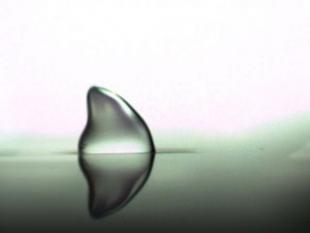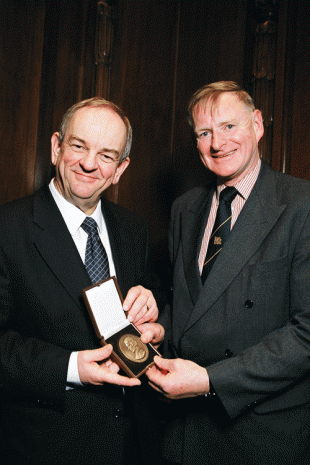The Institute for Imaging, Data and Communications at Edinburgh can trace its roots back to the signal processing research which started in 1970/71 with the arrival of Jeffrey Collins and Peter Grant. In this pre-digital era, they secured research council and MoD contracts to research into surface acoustic wave (SAW) tapped delay line (FIR) matched filters and convolvers.
Initially, the research interests were in SAW devices and in particular programmable analogue matched filters, employing hybrid microelectronic switching matrices and acousto-electric convolvers for detecting phase coded waveforms. We pioneered the application of these programmable devices as (military) spread spectrum communication receivers. One notable achievement was the design and construction by John Hannah of a prototype SAW spread spectrum synchroniser for use on UK warships with the Skynet 4 system. We also made significant contributions to the design of SAW analogue discrete Fourier transform processors, (Jack, Grant and Collins, IEEE Proceedings, April 1980), investigating their application to wideband signal analysis and applied these to the realisation of fast, coherent, frequency hopped waveform synthesisers, (Collins & Grant, IEE Proceedings Pt F, June 1982). This initial thrust into spread spectrum receiver module design was reported annually at the IEEE Ultrasonics Symposium through the 1970s and early 80s. Award winning papers from this era received the IERE Bulgin and Mountbatten premia in 1977 and 1982.
These processors, which were more compact than early digital processors, were used as low power, wideband spectrum analysers for signal intercept and for FSK detection in satellite communication systems. We thus have a continuing interest in military spread spectrum communication and electronic support measures equipment for the gathering, analysis, sorting and classification of electronic signals.
The 1980s saw these studies move to digital signal processing (DSP) and, in particular, investigation of adaptive filter designs using LMS and RLS algorithms which culminated in the Cowan and Grant authored Prentice-Hall 1985 research monograph, which was also translated into Russian. Linear adaptive filter research covered block adaptive filters, self-orthogonalising design for improved convergence rate. The natural extension by Cowan, Grant and Mulgrew into nonlinear adaptive filters covered investigations of neural network approaches based on multi-layer perceptrons (MLP) but the major contribution at this time was the application of the radial basis function (RBF) to achieve a high performance Bayesian adaptive filter for many applications, particularly for the non-stationary, non-Gaussian, nonlinear signal scenario. The particularly significant paper on the orthogonal least squares processor design (IEEE Transactions on Neural Networks, March 1991) has received over 1200 citations, due to its widespread applicability in the training of linear-in-the-parameter neural networks and adoption by researchers in the sparse signal representation community as a computionally efficient method for orthogonal matching pursuit. This work was further recognised by the award of the IEE Marconi premium for the Chen, Grant and Cowan IEE Proceedings Part F, December 1992 paper.
Other notable advances at this time were led by Steve McLaughlin, who while he held a 10-year prestigous Royal Society - University Research Fellowship, developed a new statistical characterization for impulsive noise which was subsequently incorporated into ETSI standards as well as the test specifications for VDSL and SDSL (i.e. for digital subscriber line or broadband) systems.
The 1990s saw the emergence of spread spectrum systems for cellular mobile CDMA communications and Edinburgh was well placed to combine its earlier analogue matched filter expertise with the advanced DSP algorithms, which we had developed for signal analysis and interference reduction. Research thus focused on RAKE and other advanced receiver designs. One notable achievement was the first demonstration of the use of successive cancellation to reduce CDMA multi-user interference (Mowbray, Grant and Pringle, IEE Proceedings Part F, October 1992) which was a precursor to the multi-user detection (MUD) techniques developed by other researchers in the later 1990s. The Edinburgh work on intelligent arrays for CDMA base-stations, which was a precursor to the development of multiple input multiple output (MIMO) systems, was recognised by Nortel, through their invitation for us to partner in their "Smart Antennas" international universities consortium.
In 1996 we were invited to join the virtual centre of excellence in mobile and personal communications, Mobile VCE, an industry-university consortium for advanced pre-competitive research into 4th generation mobile systems design. Over the 1996-2012 period, our income from Mobile VCE has exceeded £3M and the research has resulted in many successful patent awards, an input to a European standards body, with many journal and international conference papers. Steve McLaughlin was academic coordinator on the wireless access work area in Core 2 for which he was praised by the industrial members for his inspired leadership and drive. The current research in Core 5 programme is focused on achieving lower power "Green Radio" base-station designs. The technical assessment of these research programmes has consistently been outstanding. In 2002 and 2007 Grant was elected to serve as a director on the executive board of the Mobile VCE.
At this time, other lines of research developed into speech, analysing noise in DSL systems, signal and image processing for improved radar signal detection, and analysis of traffic signals. Our most significant advances in knowledge transfer have been in the area of speech recognition and synthesis where Mervyn Jack's group have delivered prototype systems for timetabling, electronic banking and advanced call center design. This has been supported by the railway industry and BT with, at the moment, particularly active support from the banking sector.
Mulgrew, Grant and Thompson published the 1997 Macmillan/Palgrave DSP textbook for BEng first degree students, which was reprinted twice, translated into Taiwanese, with the second edition published in 2003. Grant's Prentice-Hall 1998 undergraduate textbook on Digital Communications has likewise been reprinted many times, the third edition was published in 2009 by Pearson Education and it is now translated into Chinese with English reprints by China Machine Press and further
reprints in India.
In 2002 Bernard Mulgrew signed a "Strategic Alliance" with BAE Systems and the Heriot-Watt University to drive forward radar signal and image processing research. This was a precursor to our forming in 2005 a joint research institute (JRI) in Signal and Image Processing (SIP) with the Heriot-Watt image processing researchers. By 2009 the JRI-SIP had grown to over 135 researchers, the largest such group in the UK, with research awards growing over the 2005-9 period from £3M p.a. to £9M p.a. The new funding also saw the appointment of Michael Davies to the Jeffrey Hamilton Collins Chair in Signal Processing and the JRI expand into compressive sensing research.
Further recognition of the standing of the Edinburgh IDCoM research: Mulgrew received two conference best paper awards as well as a Royal Academy of Engineering research Professorship with BAE Systems/Selex Galileo. In 2007 Bernard Mulgrew and in 2009 Steve McLaughlin were both elected FREng. In 2004 Peter Grant was awarded the IEE Faraday Medal for his achievements in "signal processing and adaptive filter design" and in 2009 an OBE.





